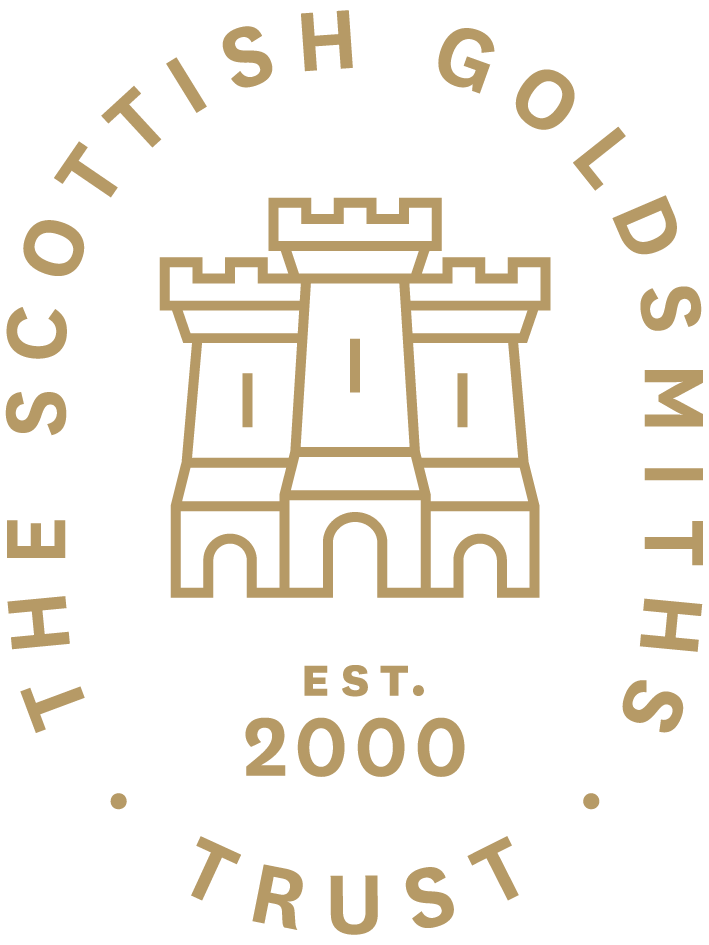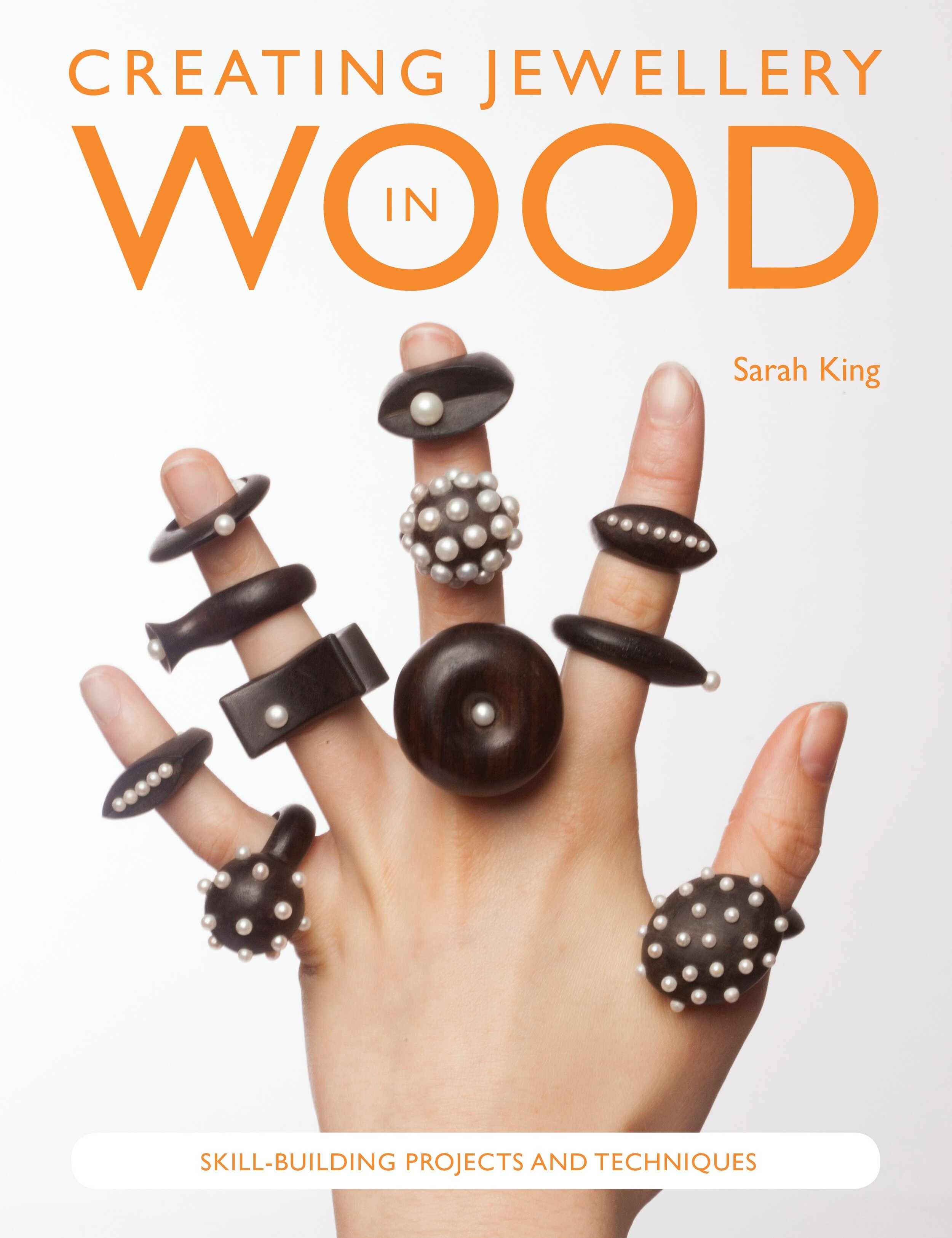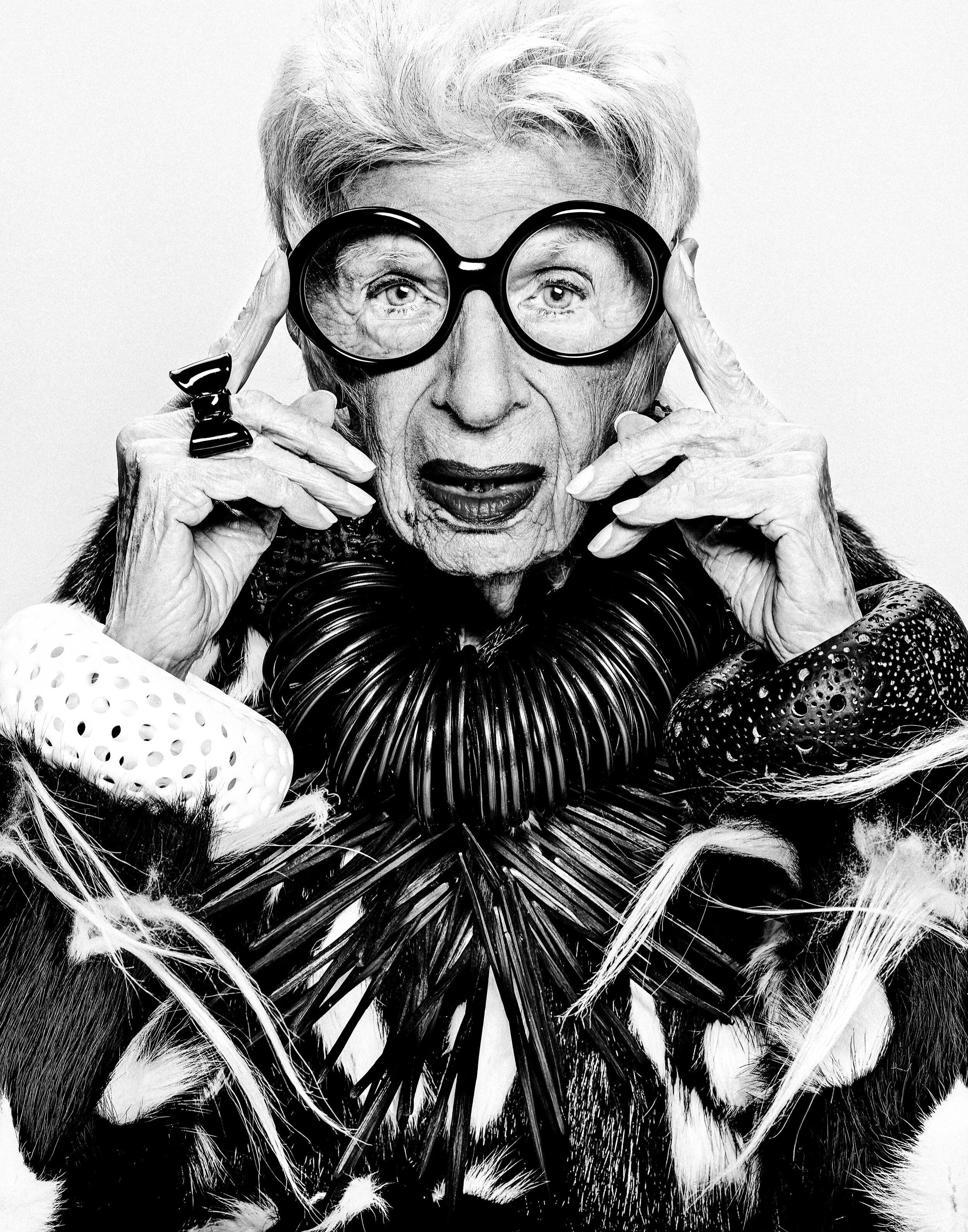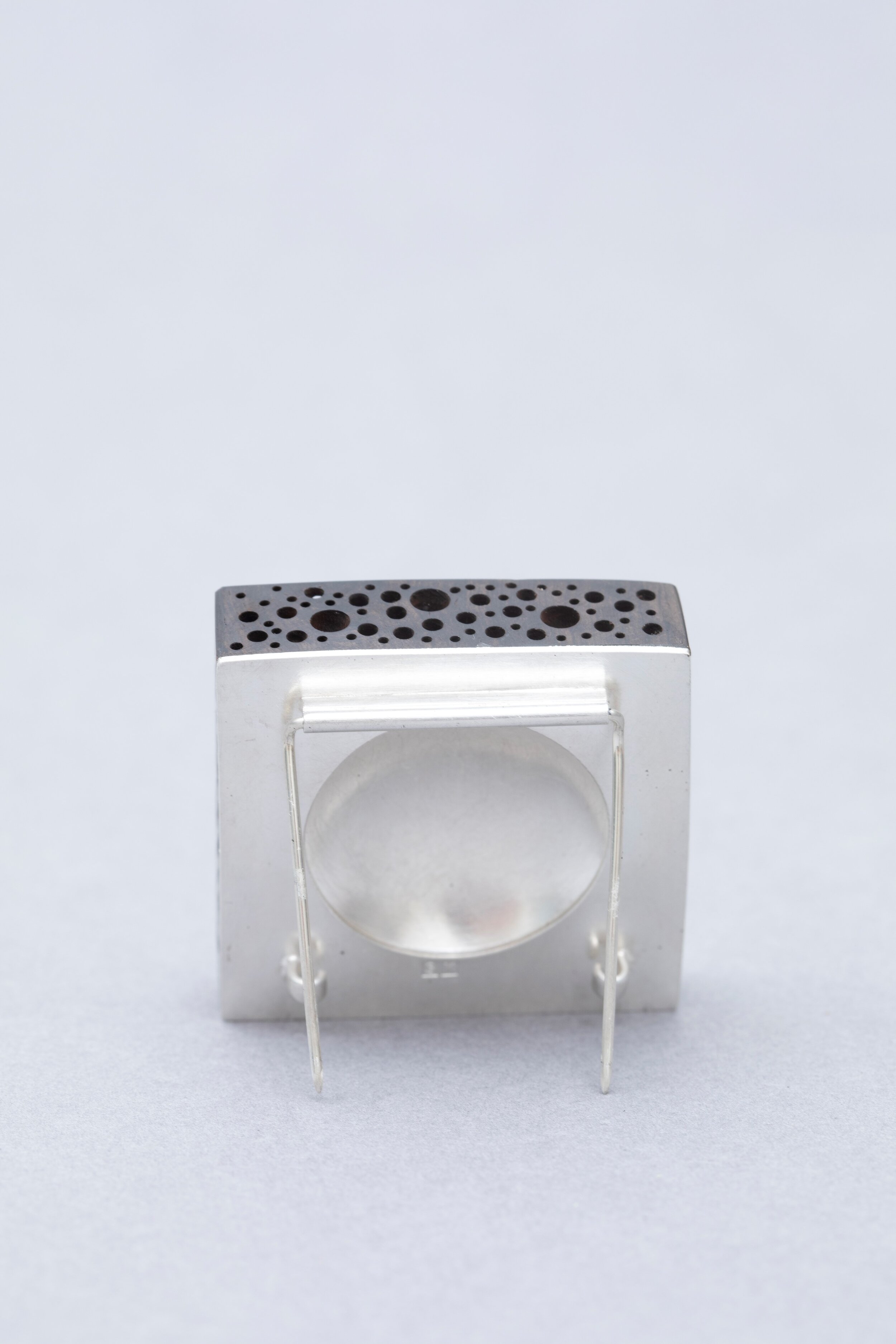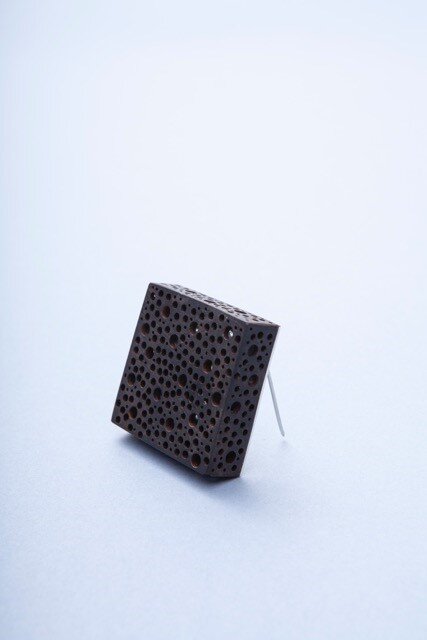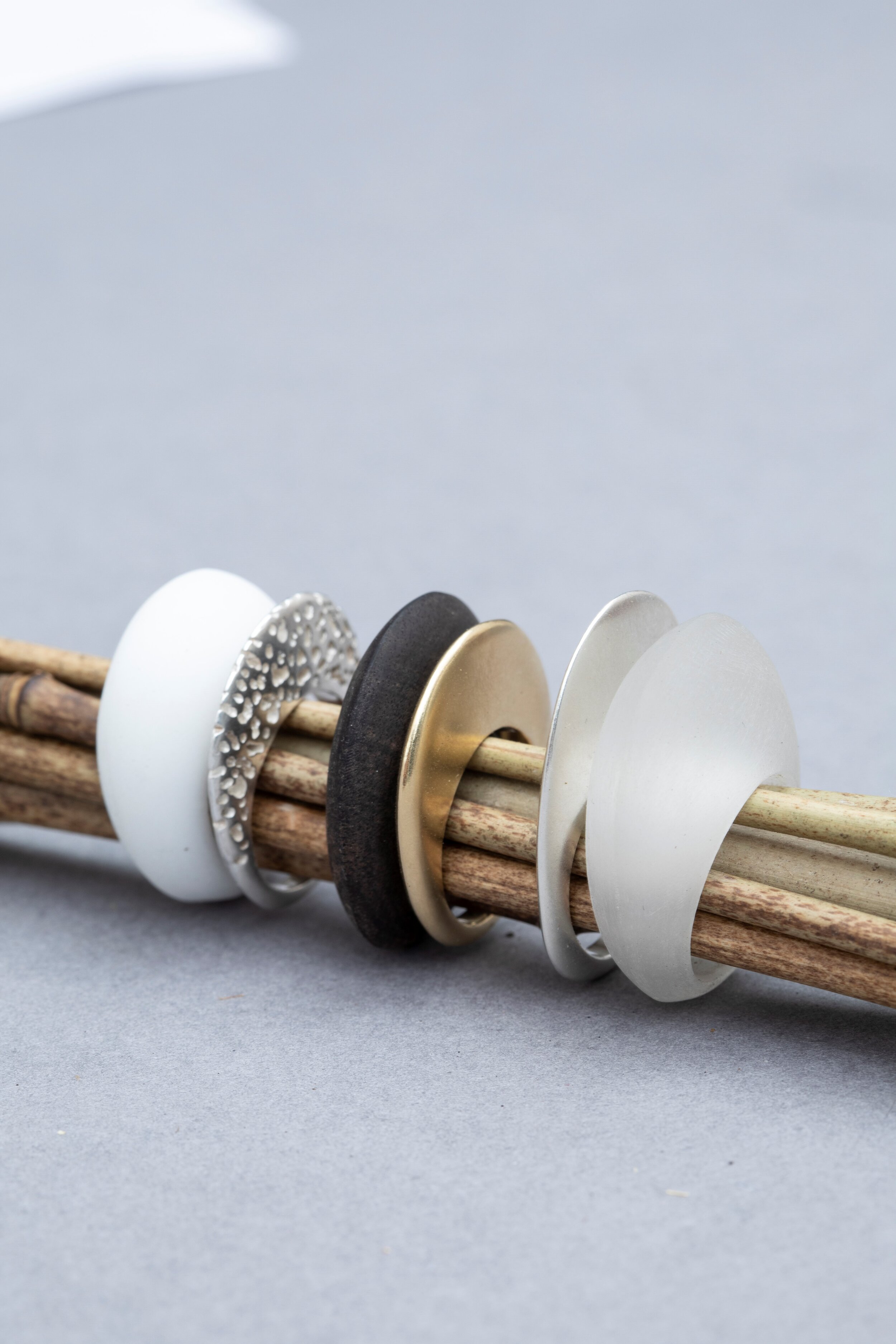Incorporating Alternative Materials: Sarah King and Wood, Bioresin and Precious Metals
Incorporating Alternative Materials: Sarah King and Wood, Bioresin and Precious Metals
Join us as we look at the materials jewellers and silversmiths work with alongside precious metal. Jeweller Sarah King incorporates alternative materials like bioresin and wood into her contemporary jewellery pieces.
Primarily self-taught, jeweller Sarah King began her career in the 1990s, creating early collections of pared-down silver pieces sold at Barneys in New York City and Liberty in London. She soon began to experiment with new materials, becoming interested in the applied arts and an early adopter of sustainable plastics. At the turn of the millennium, Sarah pioneered the use of bio resin in jewellery—a casting resin made primarily of sunflower seed oil developed by a German chemist. Sarah’s pieces can be found on the pages of publications like W Magazine, featuring her wood pieces worn by Kate Moss, or photographs of Iris Apfel wearing bio resin bangles.
Over time, Sarah’s interest in alternative and sustainable materials led her to exploring the use of wood in jewellery alongside precious metals like silver and gold. This serves as the main premise for her 2019 book Creating Jewellery in Wood, published by Fil Rogue Press. Below, Sarah discusses the development of the book and her growing interest in using alternative, sustainable materials like wood in creating contemporary jewellery pieces. Sarah spoke to our Ethical Making Programme Officer, Emily MacDonald, about working with these versatile materials alongside precious metals.
Creating Jewellery in Wood by Sarah King
Iris Apfel wearing bioresin bangles by Sarah Photo: © Guerin Blask
‘My main premise for the book is to explore wood as an exciting and versatile material for contemporary jewellery. My style is to use materials in a tactile sculptural way in quite bold pieces and this is reflected in the projects. I wanted to combine the imaginative way wood is used by studio jewellers alongside very practical advice through step-by-step projects. There is a diversity of work in wood that I thought would challenge people’s preconception of wooden jewellery and would make a lasting and inspiring book.’
‘I have been teaching Short Courses on the use of wood at Central St Martins, Morley College and West Dean for 15 years and, when I was approached by Fil Rouge Press to write this book, I was aware that there was a lot of exciting work that either hadn’t been published or gathered together in one place. The few books on wood in jewellery tend to be narrower in their scope, focused on exotic hardwoods and not including contemporary thinking on sustainability.
From a personal perspective, it was an opportunity for me to explore more deeply the ethical, technical, and visual possibilities of making jewellery in wood. Having pioneered the use of bio resin, an eco-plastic, in my own work it was desirable to expand on similar concerns to a more readily accessible material.
Brooch made of silver and wood
I approached the book very much as a jeweller rather than a wood or sustainability expert. To make a wood piece of jewellery the choice of wood, the shaping technique, the linking mechanism and finishing, all need to be thought through as a whole which can be quite bewildering on top of the design and ideas. My projects are meant as starting points for experimentation not an end point.
I wanted a sustainable approach to wood as a material without being too dogmatic as it is a complex topic. In certain locations having a market value to a wood can provide motivation for good maintenance and there are forward-thinking projects to grow wood sustainably for making musical instruments. So, my approach was to stress a thoughtful attitude to sourcing wood and to gather information to aid research into their potential vulnerability. The projects, and the profiled jewellers, stress that with imagination more humble woods can be made into striking pieces. This might be finding a more local alternative to a wood (for instance Bog Oak rather than ebony) or ebonizing local oak to give a dark appearance lacking in our native species.
I particularly enjoyed writing the short introductory piece on the history of in the contemporary jewellery context and interviewing the four studio jewellers who make very different but stunning pieces with wood as their main material – Inni Parnanen, Beppe Kessler, Lina Peterson and Terhi Tolvanen.
The Projects in the book are loosely divided into 3 sections:
1. Section on Shaping (carving woods of differing hardness and thicknesses, turning, carving cork, curving veneers, laser cutting).
2. Section on Constructing (cold connections, linking mechanisms, laminating, riveting, making findings, threading, setting).
3. Section on Surface Techniques (silver & pearl inlay, painting + staining, gilding, electroforming, sandblasting, Shou Sugi Ban).
Wood, bioresin and silver necklace and earrings
Rings in gold, silver, wood and bioresin
There are projects suitable for beginners and professionals, with guidance at the back of the book on the varying difficulty of the individual projects, suggestions on how to simplify them or develop them further. This book would help jewellery and craft students to broaden their material possibilities and understand what innovations have already been made within their field using wood. For wood workers, it would help them change scale and make successful jewellery. And, although it is primarily a practical book, it addresses lots of different ways to approach the use of wood with technical innovations which would be useful to accessories and design students.’
For Sarah, ‘Wood is an abundant self-generating material that can be so versatile as an element for jewellery. It can be used in practical ways, for instance to add volume to a piece, as a contrast to other materials or as a substructure for other components. In my own work I am currently experimenting with sandblasted wood juxtaposed with frosted translucent bioresin. It can also be used in a poetic manner as trees and nature itself are universal themes and never more relevant as we all address current environmental challenges.’
Our thanks to Sarah for speaking with us about her work and passion for alternative and sustainable materials.
You can learn more about Sarah King’s work by visiting www.sarah-king.co.uk or @sarah_king_jewellery on Instagram.
